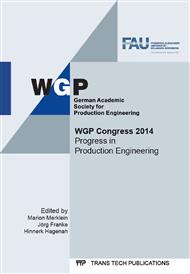p.253
p.261
p.269
p.277
p.285
p.293
p.301
p.309
p.317
Process Chains for Fibre Metal Laminates
Abstract:
The combination of fibre-reinforced materials with metals is defined as a fibre metal laminate. These material composites have already been a subject of research for several years. The long manufacturing time resulting from the period required for consolidation of the thermosetting resin is a major disadvantage of the fibre metal laminates previously in use (for instance GLARE, which is a combination of aluminium with glass fibre-reinforced plastic). In this paper, a new fibre metal laminate with a thermoplastic resin in the carbon fibre-reinforced plastics (CFRP) is introduced. The application of a thermoplastic resin system results in a general change in the process chain. The cutting of fibre metal laminates by means of the flexible water jet and laser cutting techniques is presented. In the second operation, forming behaviour is represented by the methods of v-bending and deep drawing. Finally, quality assurance by means of computed tomography, which replaces the conventional metallographic method, is described.
Info:
Periodical:
Pages:
285-292
Citation:
Online since:
September 2014
Authors:
Keywords:
Price:
Сopyright:
© 2014 Trans Tech Publications Ltd. All Rights Reserved
Share:
Citation:


